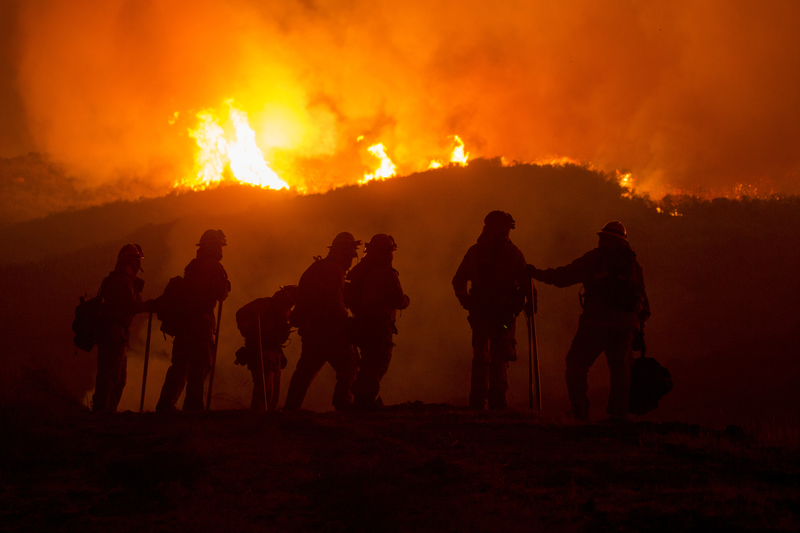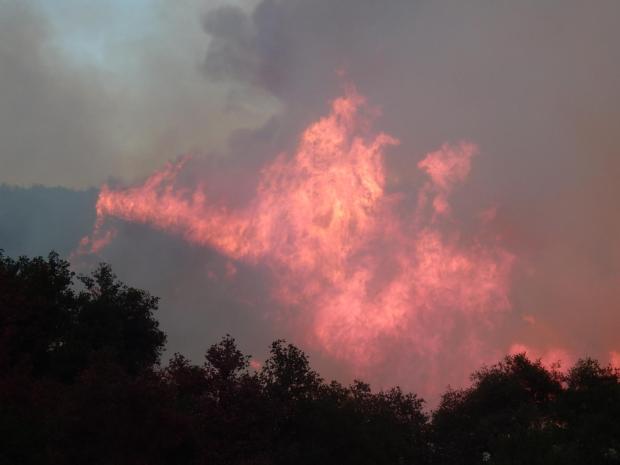
The $1.3 trillion spending bill headed for a vote in Congress this week includes a bipartisan measure creating a disaster fund to help fight the wildfires that have swept Western states in recent years.
Fundamentally changing how the U.S. Forest Service and other agencies pay for wildland firefighting, the bill would set aside more than $20 billion over 10 years in an emergency fund that could be tapped when firefighting budgets are depleted.
In the past, the Forest Service has been forced to raid non-fire accounts to pay for firefighting costs, thereby depleting funds needed for timber management, prescribed burning and other fire-prevention work.
Last year, federal firefighting costs reached a record $2.7 billion.
The bill also would eliminate an existing funding mechanism that ties each year’s firefighting budget to the 10-year average for wildfires – a practice that left accounts increasingly short as wildfires burned wider swaths over longer periods each year.
Western senators, Forest Service officials and other forest advocates have long sought a comprehensive funding fix for firefighting agencies – and an end to so-called “fire borrowing.”
If approved, the measure would use a budget cap adjustment to create an account that would receive between $2.1 billion and $2.9 billion per year, beginning in fiscal year 2020 and ending in 2027. (The amount placed in the account would increase by $100 million each year.)
Federal firefighting agencies could tap into the account after their normal firefighting accounts were depleted.
The 10-year average computation of fire suppression costs – the method used to fund the Forest Service’s firefighting account – would be frozen at the 2015 level of $1.4 billion. Coupled with the ability to tap into the emergency firefighting fund, the provision would eliminate the “borrowing” of money from unrelated accounts.
Congressional leaders from across the West immediately praised the funding fix after receiving a copy of the spending bill Wednesday afternoon.
“With the pressures that wildfires have brought to the West, as well as the challenges of climate change and development, the antiquated way we pay for firefighting needed dramatic change,” said Sen. Michael Bennet, a Colorado Democrat. “This bipartisan fix transforms and modernizes the Forest Service’s capacity to restore forest health and mitigate and fight wildfires.”
“Common sense has finally prevailed when it comes to how the Forest Service pays to fight record-breaking forest fires that devastate homes and communities in Oregon and the West,” said Sen. Ron Wyden, an Oregon Democrat.
“This long-overdue, bipartisan solution to the madness of ‘fire borrowing’ will at last treat these infernos like the natural disasters they are, with the benefit that millions of dollars will now be liberated each year for essential wildfire prevention,” Wyden said in a statement.

“This funding boost will allow the Forest Service to prioritize work in areas closest to communities, in order to save lives and reduce the risk of property damage, while still protecting essential public lands and existing environmental laws,” said Washington Sen. Maria Cantwell, the top Democrat on the Senate Energy and Natural Resources Committee.
In Montana, Democratic Sen. Jon Tester said firefighting costs have consumed as much as 50 percent of the Forest Service’s budget in recent years, dramatically influencing the agency’s ability to manage the national forests.
“For years, the Forest Service has seen its budget ravaged by growing wildfire costs,” he said. “These costs drain resources needed to build and maintain trails, conduct research and cut a few trees for more fire mitigation.”
Republican Rep. Mike Simpson of Idaho, who chairs the subcommittee on energy and water development appropriations, said the wildfire disaster fund is one of the most significant pieces of legislation he’s worked on as a congressman.
“Fire borrowing was intended to be an extraordinary measure,” he said, “but as fire seasons have grown more destructive it has become common practice – and has created a devastating cycle that prevents agencies from doing needed hazardous fuels removal or timber harvests, leading to worse fires.”
Montana Republican Sen. Steve Daines said the spending bill’s provisions also will streamline fire-prevention projects by permitting new categorical exclusions for hazardous fuel reduction, meaning less paperwork stemming from environmental reviews.
The measure includes $100 million for fire prevention projects and recreation programs and – because of last fall’s infernos in California – specifically allows utilities to work with the Forest Service to prevent trees from touching power lines.
Votes on the spending bill are expected no later than Friday, since the federal government’s funding expires on Saturday.

I did not think the “fire-fix” would happen. I am glad I was wrong.
As I read the information, essentially there is emergency funding for wildfire for 2020-2027, going from about $2.25 to $2.95 billion. And, the really great news is the 10-year average for fire suppression used by the Forest Service for budget development is frozen at $1.4 billion.
This says to me the “fire-transfer” will stop (great news) and the escalating percentage of fire as part of the Forest Service budget will stop at about 54 percent – the current level (more great news).
Now, what about the other side of this equation. That is, “…an expanded forest management program to ensure effective fire management.” Otherwise, it seems to me, the Forest Service — and the associated direct and indirect role of forest stewardship along a rural to urban land gradient — is still stuck.
Yes, the Forest Service is not moving so quickly toward 70 percent of its appropriated budget for fire, but what about “…the 16 percent (in 1996) – 54 percent (2018) chasm” that has been created over the last twenty years? Recall, there has been a shift of about 40 percent of the skills set from other programs to fire. Essentially, there is a “forest management chasm” that needs to be addressed.
My fear: Now, the Forest Service simply has more funds to fight wildfire (“base plus emergency”). And we know, wildfires can be really wasteful on the land resources (soil, wildlife, flooding, etc.); eliminating forest products; and, reducing markets.
The Driving Question: Are there provisions in the Omnibus Spending Bill to begin the badly needed forest restoration journey? That’s the minimum +$1.3 billion figure I have often mentioned: funds to enhance forest management.
I do not want to come across as not happy or grateful for the “fire-fix”. Clearly, I am. This stops a really bad practice of “robbing Peter to pay Paul” and slows the movement of the agency toward a “USDA Fire Service.” But, the “fire-fix” does not, by itself, address the restoration and conservation balance that is so desperately needed across the country and especially on the National Forests.
It seems to me, unless I simply cannot find the provisions in the proposed spending Bill, a wide-range of interests now need to band together to address the “forest-fix” facing America.
Very respectfully,
I am glad they finally fix it. Now the need to start managing the Forests as they were set up for! Harvesting and thinning the forest to reduce the fuel load and utilize the resource the is being wasted (timber). Start putting money into the treasury instead of taking it out and wasting the resource!!